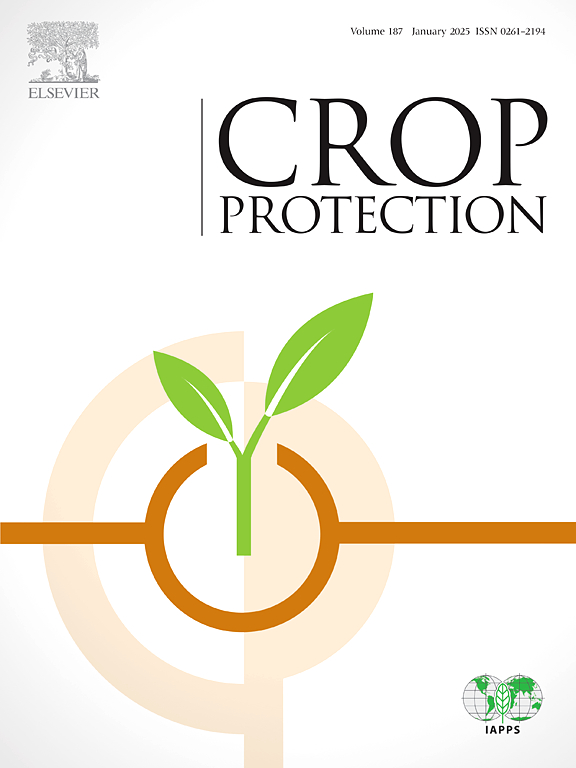单萜类、苯丙烯类和倍半萜类在防治B型烟粉虱中的应用潜力(半翅目:烟粉虱科)
IF 2.5
2区 农林科学
Q1 AGRONOMY
引用次数: 0
摘要
研究了单萜、苯丙烯和倍半萜等13种植物化学物质对番茄成虫的杀虫、驱避和阻卵活性。熏蒸剂毒性试验中,对伞花烃、α-松蒎烯和α-蒎烯的LC50值分别为9.64、11.74和14.35 μl/L,熏蒸剂毒性最高。接触毒性试验中,反式肉桂醛的杀虫活性最高(LC50 = 1.36 mg/L),其次是丁香酚(1.42 mg/L)。相比之下,法尼醇、(Z, E)-神经醇、α-蒎烯、α-松蒎烯和对伞花烃表现出较弱的接触毒性(LC50 >;10 mg / L)。温室试验中,反式肉桂醛的接触毒性最高(83.45%),其次是丁香酚(80.62%),10 mg/L处理72h时噻虫嗪的接触毒性最高(87.75%)。反式肉桂醛(80.45%)、丁香酚(79.64%)、(−)-香茅醛(78.93%)、(1R,2S,5R)-薄荷醇(78.17%)和(−)-香芹酮(73.52%)在10 mg/L浓度下驱避效果较噻虫嗪(89.26%)好。10 mg/L的反式肉桂醛(52.30%)和丁香酚(48.56%)在24 h后的阻产卵率最高,而噻虫嗪(46.68%)的阻产卵率最高。结果表明,这些化合物可作为防治烟粉虱的生物杀虫剂。本文章由计算机程序翻译,如有差异,请以英文原文为准。
Potential of monoterpenes, phenylpropenes, and sesquiterpenes for the management Bemisia tabaci (Gennadius) biotype B (Hemiptera: Aleyrodidae)
The insecticidal, repellent, and oviposition-deterrent activities of 13 phytochemicals belonging to the monoterpene, phenylpropene, and sesquiterpene classes against Bemisia tabaci adults were evaluated on plants of tomato in laboratories and greenhouses. In the fumigant toxicity assay, p-cymene, α-terpinene, and α-pinene exhibited the highest fumigant toxicity with LC50 values of 9.64, 11.74, and 14.35 μl/L air, respectively. In the contact toxicity assay, trans-cinnamaldehyde caused the highest insecticidal activity (LC50 = 1.36 mg/L) followed by eugenol (1.42 mg/L). In contrast, farnesol, (Z, E)-nerolidol, α-pinene, α-terpinene, and p-cymene displayed a weak contact toxicity (LC50 > 10 mg/L). The highest contact toxicity in the greenhouse experiment was also observed with the trans-cinnamaldehyde (83.45%), followed by eugenol (80.62%), compared with thiamethoxam (87.75%) at 10 mg/L and 72h post-treatment. The maximum repellency was observed with trans-cinnamaldehyde (80.45%), eugenol (79.64%), (−)-citronellal (78.93%), (1R,2S,5R)-menthol (78.17%), and (−)-carvone (73.52%) at concentration of 10 mg/L after 24h compared to thiamethoxam (89.26%). Moreover, the greatest oviposition deterrence percentage was observed after 24 h for trans-cinnamaldehyde (52.30%), and eugenol (48.56%) at 10 mg/L compared to thiamethoxam (46.68%). The results indicate that these compounds may be employed as bioinsecticides for the control of B. tabaci.
求助全文
通过发布文献求助,成功后即可免费获取论文全文。
去求助
来源期刊

Crop Protection
农林科学-农艺学
CiteScore
6.10
自引率
3.60%
发文量
200
审稿时长
29 days
期刊介绍:
The Editors of Crop Protection especially welcome papers describing an interdisciplinary approach showing how different control strategies can be integrated into practical pest management programs, covering high and low input agricultural systems worldwide. Crop Protection particularly emphasizes the practical aspects of control in the field and for protected crops, and includes work which may lead in the near future to more effective control. The journal does not duplicate the many existing excellent biological science journals, which deal mainly with the more fundamental aspects of plant pathology, applied zoology and weed science. Crop Protection covers all practical aspects of pest, disease and weed control, including the following topics:
-Abiotic damage-
Agronomic control methods-
Assessment of pest and disease damage-
Molecular methods for the detection and assessment of pests and diseases-
Biological control-
Biorational pesticides-
Control of animal pests of world crops-
Control of diseases of crop plants caused by microorganisms-
Control of weeds and integrated management-
Economic considerations-
Effects of plant growth regulators-
Environmental benefits of reduced pesticide use-
Environmental effects of pesticides-
Epidemiology of pests and diseases in relation to control-
GM Crops, and genetic engineering applications-
Importance and control of postharvest crop losses-
Integrated control-
Interrelationships and compatibility among different control strategies-
Invasive species as they relate to implications for crop protection-
Pesticide application methods-
Pest management-
Phytobiomes for pest and disease control-
Resistance management-
Sampling and monitoring schemes for diseases, nematodes, pests and weeds.
 求助内容:
求助内容: 应助结果提醒方式:
应助结果提醒方式:


